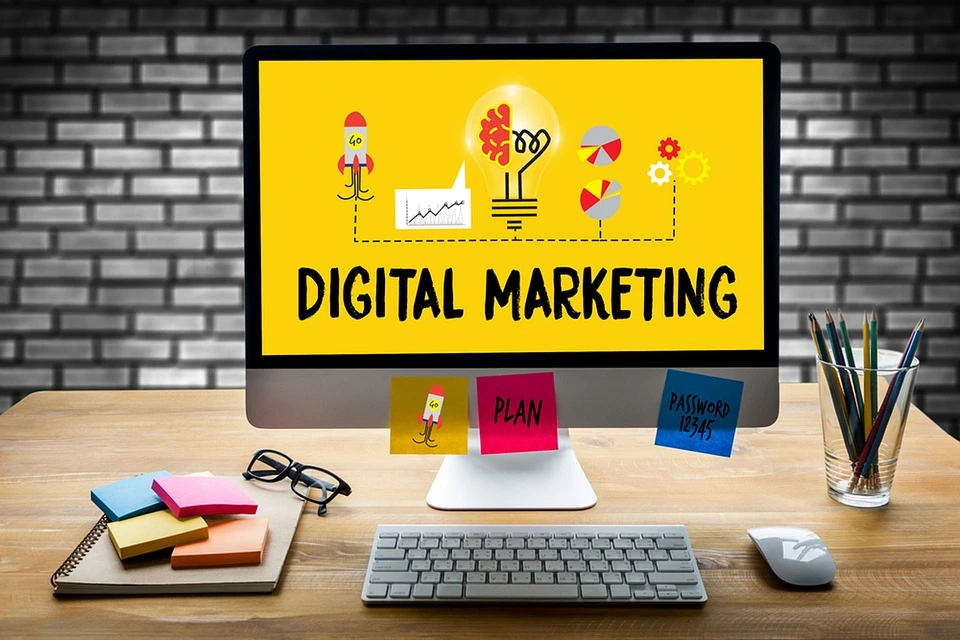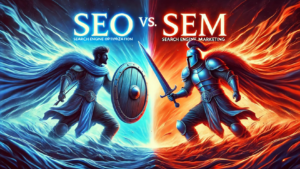The digital advertising and marketing industry is booming! In 2024, it was expected to hit around $667 billion, and by 2026, it could grow to $786.2 billion. That’s $120 billion which is huge. (Stats Source: Local IQ , Marketingreport.one)
With nearly two-thirds of businesses already spending more on digital marketing, it’s clear that this space is only getting bigger and more competitive. Basically, it is just getting started, with AI coming into power, even digital marketers cannot imagine the possibilities of their own creativity. But no matter how far it gets, basics will always be the pillars! So let’s check on this world of what digital marketing actually is!
What is Digital or Online Marketing?
Promoting your products or services with the use of digital channels is Digital or Online marketing. I know this answer might’ve sounded like the textbook answers but it is the simplest way to get clear.
Now, what “channels”? These channels can be search engines like google, social media like facebook or instagram, emails, websites and more. So basically, any channel or platform that uses the internet can be used for digital marketing in multiple ways. But is it really okay to use “any channel”? We will come to that further in this blog.
Unlike traditional marketing, which relies on print ads or television, digital media marketing allows businesses to engage with audiences in real time.
Okay, many of them do not cover this, digital marketing has multiple names. It is also called as online marketing, e-marketing, internet marketing, web marketing. Few also refer to it as social marketing but it is a subset of digital marketing.
Difference Between Digital Marketing and Traditional Marketing?
Feature | Digital Marketing | Traditional Marketing |
Reach | Global | Local or regional |
Cost | More cost-effective | Expensive (TV, radio, print) |
Engagement | Interactive and real-time | One-way communication |
Targeting | Highly targeted | Broad audience targeting |
Analytics | Measurable with real-time insights | Difficult to measure |
Conversion Rate | Higher with precise tracking | Lower due to general audience targeting |
Example Channels | SEO, PPC, Social Media, Email Marketing | TV, Newspapers, Billboards, Flyers |
The Benefits of Digital Marketing
1. Reach More People, Faster
Billions of people use the internet every day. That means businesses can reach way more people online than they ever could with a newspaper ad or a billboard.
For example, let’s say a small clothing brand launches a new collection. Instead of just putting up posters in their city, they can run Instagram and Facebook ads that show up in front of people who are actually interested in fashion—no matter where they live. This makes digital marketing way more effective than hoping the right person sees a street ad.
2. More Affordable Than Traditional Ads
TV ads, billboards, and newspaper spots cost a lot, and there’s no guarantee they’ll work. Digital marketing, on the other hand, lets businesses spend only what they can afford—and adjust their budget whenever they need to.
If a local bakery, instead of spending thousands on a radio ad, they can use a small budget to run a Facebook promotion for their new cupcake flavors. They only pay when someone clicks on their ad, and they can stop the campaign anytime if it’s not working. They have all the cards in their hand right from the audience, placements to stopping the campaign.
3. See What’s Working (and Fix What’s Not)
Earlier, it was a gamble to do marketing activities. Think about it, you will pay as huge amount of money for hoardings and banners as you can, but deep down it is just a guess work whether it is working.One of the best things about digital marketing is that you don’t have to guess if it’s working. Businesses can see real-time stats, how many people saw their ad, clicked on it, or made a purchase.
So, basically, now you can measure if your efforts are working in real time or just change the way you do it.
Imagine an online store selling gadgets. If they run Google Ads and notice that one product is getting a lot of clicks but no sales, they can tweak the product description or adjust the price. With traditional ads, they’d have to wait weeks (or months) to know if their campaign was successful.
4. Personalize Offers Based on Customer Behavior
See Nobody likes getting random, irrelevant ads. One of the most amazing things that Digital marketing offers is to show people exactly what they’re interested in, based on their previous searches and interactions. So if a person is interested in being a consumer of your products or services, they might have searched some or the other thing about it.
Now that search is capture and they are shown the ads about the thing they are interested in.
OKay I will explain, if you browse running shoes on an e-commerce site, there is a high chance of you seeing ads for sneakers, workout gear, or even fitness tips. This kind of personalized marketing makes people more likely to buy because the content actually relates to them. Remember the last time this happened to you? I know I can related to it!
5. Keep Customers Engaged at Every Step
With traditional marketing, once an ad is out, you just hope people remember your brand. As I already said it is just a “guess work”. Digital marketing lets businesses stay connected with customers from the moment they discover a brand until they make a purchase—and even after that.
Umm… Consider a company selling online courses. They might start by posting free educational content on YouTube. Then, they can send emails with discounts. Finally, they can retarget the users who visited their website. These users are shown engaging ads that remind them to enroll in a course they showed interest in. This keeps the brand fresh in the customer’s mind and increases the chances of making a sale. This can sound a little spooky but yeah that is the truth.
6. Easier and Faster Conversions
Ever wanted to buy something but found the process too complicated? That’s generally not a problem with digital marketing. So, online stores and ads are designed to make it super easy to buy, sign up, or contact a business. In fact is just a matter of asking your question and a click
a food delivery app can send a push notification with a “One-Tap Order” button. No need to enter details again—just tap, and the food is on its way.
Nowadays to even buy a scooter, you get options on leading e-commerce sites. The features are easy.
Businesses like real estate have started providing virtual tours of their spaces along with voiceover details making the buyer comfortable and increasing their trust.
Types of Digital Marketing
1. Content Marketing – Educate, Engage, and Build Trust
People don’t like being sold to all the time. Instead, they want information, solutions, and stories that add value to their lives. That’s exactly what content marketing does—it creates useful blogs, videos, podcasts, and infographics that help people while naturally positioning a brand as an industry expert.
Think about it. When you search for “how to improve sleep,” you find articles and videos, here, you are a part of someone’s strategy. But it is fine to be their audience because they are providing you the solution.
I would like to mention something here, a lot of times due to human tendency, we may feel “tricked” by businesses to show the free content first and then showcasing their products or services. But we need to understand that the business they started was to solve a specific problem or to make lives better.
It is a great thing that they are providing a free resource to us, otherwise earlier, there was nothing we used to get for free and today, there is the entire world. Thanks to digital marketing!
By providing genuine value, brands not only attract customers but also build trust. When it’s time to buy, people remember the brand that helped them first. Which is honestly the most ethical way of doing business.
2. Search Engine Optimization (SEO) – Get Found Where It Matters
Now this is the most complicated, but a Game Changer!
People turn to search engines like Google for answers to everything. Search Engine optimization is making the most of your online presence to appear on top of the search engines whenever people are searching. And it is not just Google, it is Yahoo, Bing, Duck Duck Go and much more.
SEO helps businesses show up at the top of search results when potential customers look for relevant terms like “what is digital marketing” or “best skincare products for oily skin.”
Or local searches like “salon near me” or “italian restaurant in [city]”
People also have a tendency to search for a few products or services on Google with keywords like “black sports shoes” or “social media agency” which gives you potential to showcase your business.
Why does this matter? Because most people don’t go past the first page of Google. If your business ranks higher, you get organic traffic without paying for ads. Plus, people subconsciously trust search engine results—they assume that if Google recommends it, it must be good which is the real case because it is not a piece of cake to rank on Google unless you are trusted.
There are 200+ factors to rank on Google which makes it really tuff.
In today’s date, LLMs like ChatGPT and Gemini and Deepseek are also used for searching the answers. This made the game pretty complicated as for the last two decades, Google never went down on Search Engine market share but this can be an alert for all to reconsider SEO from “Search Engine Optimization” to “Search Everywhere Optimization”
3. Search Engine Marketing (SEM) – Pay to Show Up Instantly
While SEO takes time, SEM (paid advertising) brings instant visibility. With platforms like Google Ads, businesses can show up at the top of search results immediately by bidding on relevant keywords.
This works great for businesses that need quick results or have high competition in their industry. If someone searches for “best running shoes,” brands that use SEM can make sure their ad is the first thing potential customers see.
4. Social Media Marketing (SMM) – Build a Community, Not Just Customers
Social media is where people spend hours every day, and businesses that engage there build strong brand connections. Whether it’s Instagram, Facebook, LinkedIn, or TikTok, social media marketing helps brands interact with customers, showcase products, and even go viral.
The key here is engagement. It’s not just about posting ads—it’s about creating content that sparks conversations, makes people laugh, or teaches them something new. Brands that do this well don’t just sell; they become part of their audience’s daily life.
5. Pay-Per-Click (PPC) Advertising – Fast Results with Targeted Ads
PPC ads are exactly what they sound like—you pay only when someone clicks on your ad. Whether it’s on Google, Facebook, or Instagram, PPC helps businesses reach the right people instantly.
This is especially useful when launching a new product or running a limited-time offer. Instead of waiting for organic traffic, businesses can boost visibility right away and drive targeted traffic to their website.
6. Affiliate Marketing – Let Others Sell for You
Affiliate marketing is a win-win strategy where businesses partner with affiliates (bloggers, influencers, or websites) who promote their products in exchange for a commission.
This works well because people trust recommendations from real people more than direct advertisements. If a well-known tech blogger recommends a laptop, their followers are more likely to buy it than if they just saw a company’s ad.
7. Email Marketing – Stay in Your Customer’s Mind
Email marketing is like having a direct line to your audience. It allows businesses to send personalized content, special offers, and updates straight to their customer’s inbox.
When done right, email marketing doesn’t feel like spam—it feels like a conversation. People are more likely to engage when emails are relevant, timely, and offer value rather than just sales pitches.
8. Video Marketing – Capture Attention Instantly
Videos have a unique power—they combine visuals, sound, and storytelling, making them the most engaging content format. Whether it’s a short TikTok clip or an in-depth YouTube tutorial, video marketing grabs attention and keeps people engaged.
Brands that use video effectively build stronger emotional connections with their audience. A well-made brand story or behind-the-scenes video can make people feel something, which is far more powerful than just reading text.
9. Mobile Marketing – Meet Customers Where They Are
Everyone is glued to their phones. Mobile marketing ensures that ads, emails, and websites are optimized for mobile users. Whether it’s an app notification, an SMS offer, or a mobile-friendly ad, businesses that focus on mobile create a frictionless experience for users.
For example, a restaurant sending out an SMS discount at lunchtime can drive immediate orders because it reaches customers at the right place, at the right time.
10. Influencer Marketing – Leverage Social Proof
People trust people, not ads. That’s why influencer marketing works so well—it’s like a recommendation from a friend. When influencers genuinely use and talk about a brand, their audience listens and takes action.
This is especially effective for industries like beauty, fitness, and tech, where consumers look for trusted opinions before making a purchase. A single influencer post can drive massive engagement and sales—because it doesn’t feel like traditional advertising.
How to Build a Digital Marketing Strategy
1. Define Your Goals
Identify business objectives such as lead generation, brand awareness, or customer retention.
2. Identify Your Target Audience
Use market research and analytics to understand customer demographics and preferences.
3. Set a Budget for Each Digital Channel
Allocate resources wisely to maximize ROI across SEO, PPC, social media, and content marketing.
4. Select Your Digital Marketing Channels
Choose platforms based on audience behavior, industry trends, and business goals.
5. Optimize for Mobile
Ensure websites, ads, and emails are mobile-friendly for a seamless user experience.
6. Measure & Refine Efforts
Regularly analyze performance metrics and optimize campaigns for continuous improvement.
How to Outperform Competitors in Digital Marketing
- Focus on high-quality,SEO-optimized content to rank higher than competitors.
- Leverage data analytics to refine targeting and improve campaign performance.
- Invest in AI-driven marketing automation to enhance personalization and engagement.
- Use video marketing and interactive content to boost user retention and conversion rates.
- Collaborate with micro-influencers to reach niche markets with authentic messaging.
Frequently Asked Questions (FAQs)
Digital marketing involves promoting products or services through digital channels such as websites, social media, and search engines.
Key challenges include staying updated with algorithm changes, targeting the right audience, and measuring ROI effectively.
Success is measured through KPIs like website traffic, conversion rates, engagement levels, and return on investment (ROI).
Start by defining goals, researching the audience, choosing marketing channels, and tracking performance.
SEO, content marketing, social media engagement, and email marketing are effective strategies for small businesses.


